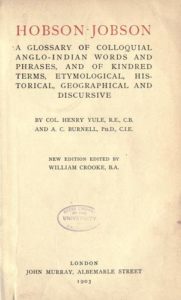Indian or South Asian English is one variety of the English language that has developed out of trading and colonization processes in the 1600s. Let’s explore some facts about Indian English!
Historical influences
The English language arrived in South Asia as a result of colonization. In the early 1600s the British first arrived in India. They soon established trading posts in a number of cities under the control of The East India Company. As a result of the growing influence of the Company, the British were controlling most parts of the country by 1875. The start of the British rule in India, which is often connected to this date, is referred to as The Raj. The British rule lasted until 1947, the year of Independence. English was initially taught to the local population by Christian missionaries.
Even though there were no official attempts to teach English to the masses, it became the language of administration by the 1700s. As a consequence many educated Indians demanded instruction in English to enable social advancement. By 1897 the first universities had opened in Bombay, Calcutta and Madras. English was increasingly accepted in administrative and public fields as it became the language of government, the social elite and the national press.
Linguistic implications
Indian English has some distinctive characteristics that set it apart from other international varieties of English such as British or American English which have developed due to its constant contact with languages spoken natively on the subcontinent. As there are more than 400 hundred native languages in South Asia, English has been and still is affected by this linguistic variety.
 The strong influence of native Indian languages is, among other areas, reflected in the English lexicon. Jungle, bungalow, punch, shawl, and veranda have made their way from native Indian languages into the English lexicon. For those of you who want to explore the linguistic influence of Indian native languages on the English lexicon there is a special dictionary called „HOBSON-JOBSON“. On more than 1000 pages you will find countless words and their meanings as well as their etymological roots
The strong influence of native Indian languages is, among other areas, reflected in the English lexicon. Jungle, bungalow, punch, shawl, and veranda have made their way from native Indian languages into the English lexicon. For those of you who want to explore the linguistic influence of Indian native languages on the English lexicon there is a special dictionary called „HOBSON-JOBSON“. On more than 1000 pages you will find countless words and their meanings as well as their etymological roots
Besides this fact, Indian English has some particular features in reference to its pronunciation. For example, speakers of Indian English do not pronounce the <th> ([θ] or [ð]) in words like „that“, „they“, or „three“. Instead, they replace the <th> by [d] or [t]. Furthermore, there is no difference between the pronunciation of [v] and [w] (v-w merging). Speakers of English in India also pronounce the <r> differently as they use the alveolar trilled version [ɽ͡r]. In the table below you find some examples with their phonetic translation and a brief description.
| Example | Phonemes | Standard English (BE/AE) | Indian English | Description |
|---|---|---|---|---|
| they | [ð] vs. [d] | [ðeɪ] | [deɪ] | /ð/ is replaced by /d/ |
| three | [θ] vs. [t] | [θri:] | [tri:] | /θ/ is replaced by /t/ |
| water | [v] vs. [w] | [ˈwɔ:təʳ] | [ˈvɔ:təʳ] | no difference between /v/ and /w/ |
| beer pear | [r] vs. [ɽ͡r] | [bɪər] (BE) [bɪr] (AE) [peəʳ] (BE) [per] (AE) | [bɪɽ͡r] [pɪɽ͡r] | Standard English [r] ist replaced by retroflex trilled version [ɽ͡r] |
Besides these phonetic features, English spoken on the subcontinent varies from region to region and each dialect reflects the regional influence of one of the many languages spoken natively.
You are interested in more articles on English varieties? On our blog you can also find an article on Australian English. Have you ever been to an English speaking country and want to share your language experiences? Don’t hesitate to contact us if you want to write about your experiences on our blog.



